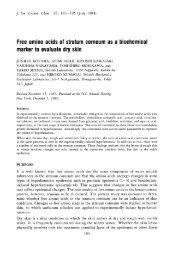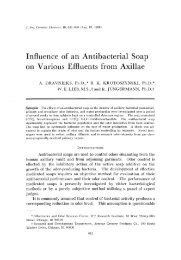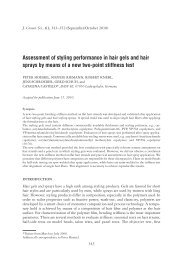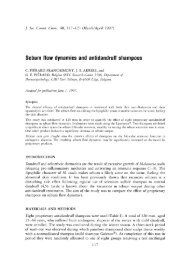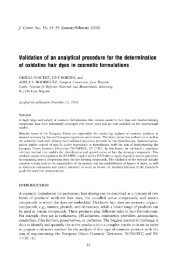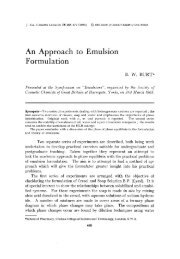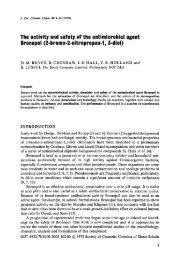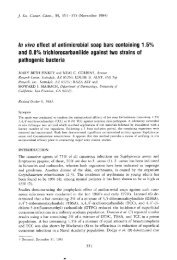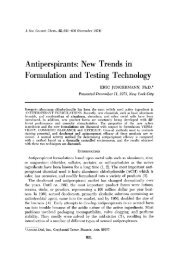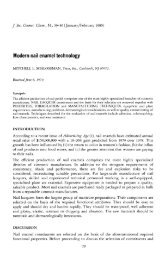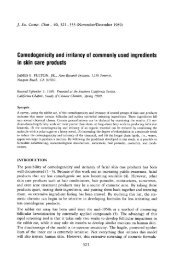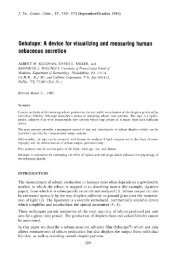A Critical Comparison of Two Procedures for Antiperspirant Evaluation
A Critical Comparison of Two Procedures for Antiperspirant Evaluation
A Critical Comparison of Two Procedures for Antiperspirant Evaluation
Create successful ePaper yourself
Turn your PDF publications into a flip-book with our unique Google optimized e-Paper software.
258 JOURNAL OF THE SOCIETY OF COSMETIC CHEMISTS<br />
dardized in detail, but depend upon the physical <strong>for</strong>m <strong>of</strong> the antiperspirant<br />
material used. When both "ambient" and "hot-room" tests are to be run, the<br />
ambient test is done on the fourth day, beginning i hour after the fourth application<br />
<strong>of</strong> the product. A preweighed "ambient" pad <strong>of</strong> non-woven fabric is<br />
placed in each axilla <strong>of</strong> each subject using a harness device or tape to hold it<br />
in position. The subjects go about their normal business <strong>for</strong> 3 hours, then return<br />
to the clinic, where the pad is removed, reweighed, and the weight inincrease<br />
recorded. The subjects return to the clinic on the fifth day, receive a<br />
fifth application <strong>of</strong> the product and i hour later enter a hot room maintained<br />
at 105øF and 50% RH. They are seated in a random spatial order around the<br />
hot room, with a nonwoven fabric pad inserted in each axilla. They are asked<br />
to sit quietly with their hands in their laps and both feet on the floor throughout<br />
the hot-room period. After 40 min., the pads are removed and discarded<br />
(pad A). A second pad, this time preweighed, is then inserted (pad B), left in<br />
place <strong>for</strong> 20 min., then removed, reweighed, and the weight gain recorded.<br />
Finally, a third pad (pad C) is inserted and handled in the same manner as<br />
pad B. This completes the test, and the subjects are dismissed.<br />
A number <strong>of</strong> details are not included in the above account, such as exact<br />
timing, randomization <strong>of</strong> the order <strong>of</strong> treating axillae, etc.<br />
In the RM method, the procedures are similar, but one, two, or more days <strong>of</strong><br />
pretest control data are obtained be<strong>for</strong>e treatments with antiperspirant begin.<br />
Confining the discussion to hot-room tests only <strong>for</strong> simplicity, these pretest<br />
runs are made both with pad B and pad C. It should be remembered that<br />
there are many variations <strong>of</strong> the RM test. Some conduct a test very similar to<br />
the SSEM just described. Others treat all subiects on one side, wait 2 weeks,<br />
then treat all on the other side. These variations, however, are variations in the<br />
experimental design and are unrelated to the central question to which we<br />
address ourselves. There<strong>for</strong>e, to demonstrate differences between the two<br />
models on an equal basis, we will assume that both protocols are identical<br />
except, in the case <strong>of</strong> the RM, <strong>for</strong> the provision <strong>for</strong> the use <strong>of</strong> pretest ratios.<br />
Statistical<br />
Considerations<br />
General<br />
The correct computational procedures <strong>for</strong> either model are dictated within<br />
rather narrow limits by the nature <strong>of</strong> the experimental design (including type<br />
<strong>of</strong> randomization) and the procedure <strong>of</strong> the protocol. Unless these particular<br />
computations are done, incorrect values <strong>of</strong> per cent reduction and/or confidence<br />
limits will be obtained. The computational procedures are there<strong>for</strong>e as<br />
important as the clinical ones and must follow valid statistical principles, take<br />
careful account <strong>of</strong> all underlying assumptions, and be compatible with the<br />
nature <strong>of</strong> the randomizations used in the experiments. These requirements



